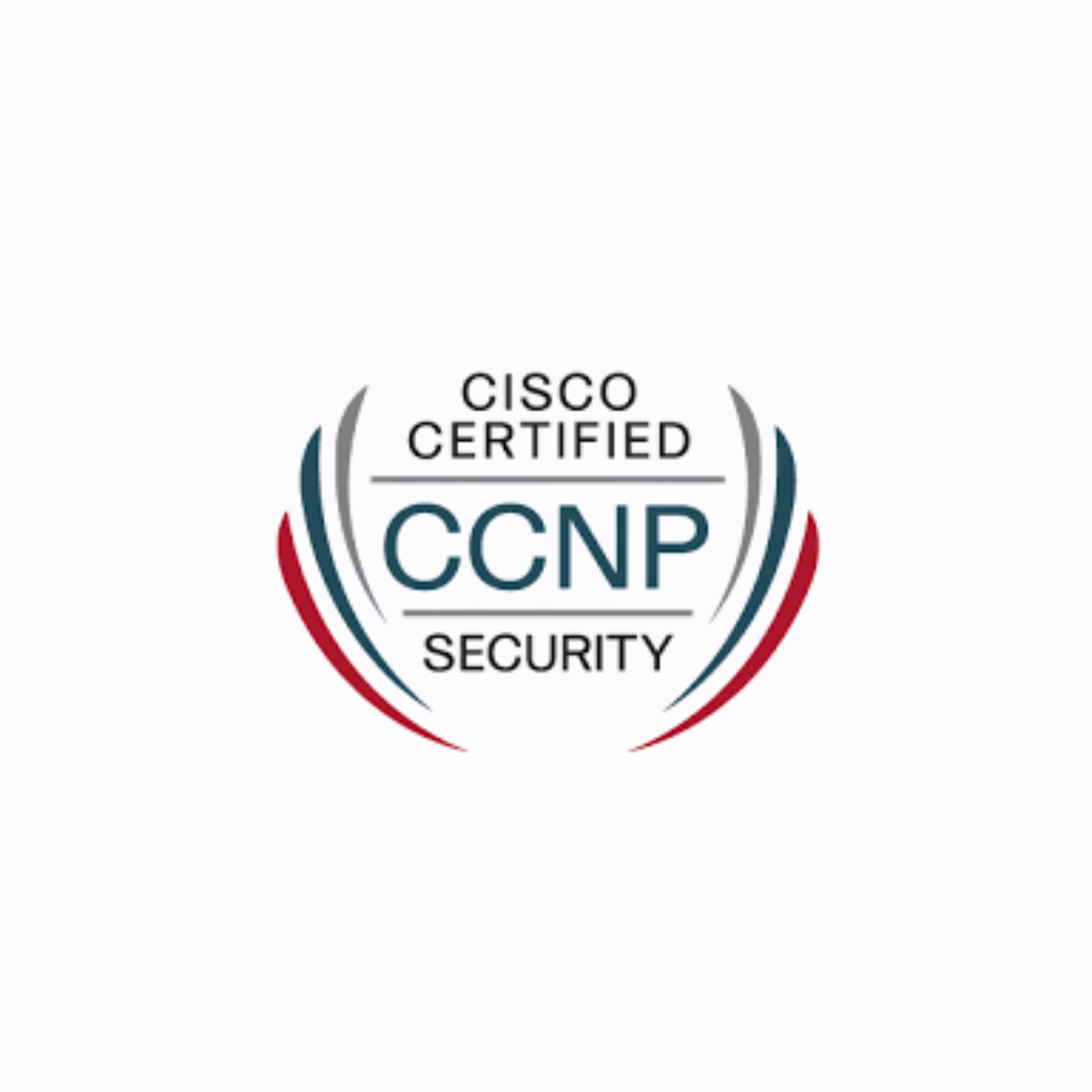
About Course
Cisco Certified Network Professional (CCNP) Security (350-701 SCOR) Course Overview
Security Concepts 25%
Explain common threats against on-premises, hybrid, and cloud environments
On-premises:
viruses, trojans, DoS/DDoS attacks, phishing, rootkits, man-in-the-middle attacks, SQL injection, cross-site scripting, malware
Cloud:
data breaches, insecure APIs, DoS/DDoS, compromised credentials
- Compare common security vulnerabilities such as software bugs, weak and/or hardcoded passwords, OWASP top ten, missing encryption ciphers, buffer overflow, path traversal, cross-site scripting/forgery
- Describe functions of the cryptography components such as hashing, encryption, PKI, SSL, IPsec, NAT-T IPv4 for IPsec, preshared key, and certificate-based authorization
- Compare site-to-site and remote access VPN deployment types and components such as virtual tunnel interfaces, standards-based IPsec, DMVPN, FlexVPN, and Cisco Secure Client including high availability considerations
- Describe security intelligence authoring, sharing, and consumption
- Describe the controls used to protect against phishing and social engineering attacks
- Explain North Bound and South Bound APIs in the SDN architecture
- Explain Cisco DNA Center APIs for network provisioning, optimization, monitoring, and troubleshooting
- Interpret basic Python scripts used to call Cisco Security appliances APIs
Network Security 20%
- Compare network security solutions that provide intrusion prevention and firewall capabilities
- Describe deployment models of network security solutions and architectures that provide intrusion prevention and firewall capabilities
- Describe the components, capabilities, and benefits of NetFlow and Flexible NetFlow records
- Configure and verify network infrastructure security methods
Layer 2 methods:
(network segmentation using VLANs; Layer 2 and port security; DHCP snooping; Dynamic ARP inspection; storm control; PVLANs to segregate network traffic; and defenses against MAC, ARP, VLAN hopping, STP, and DHCP rogue attacks)
Device hardening of network infrastructure security devices (control plane, data plane, and management plane)
- Implement segmentation, access control policies, AVC, URL filtering, malware protection, and intrusion policies
- Implement management options for network security solutions (single vs. multidevice manager, in-band vs. out-of-band, cloud vs. on-premises)
- Configure AAA for device and network access such as TACACS+ and RADIUS
- Configure secure network management of perimeter security and infrastructure devices such as SNMPv3, NetConf, RestConf, APIs, secure syslog, and NTP with authentication
- Configure and verify site-to-site and remote access VPN
- Site-to-site VPN using Cisco routers and IOS
- Remote access VPN using Cisco AnyConnect Secure Mobility client
- Debug commands to view IPsec tunnel establishment and troubleshooting
Securing the Cloud 15%
- Identify security solutions for cloud environments
- Public, private, hybrid, and community clouds
- Cloud service models: SaaS, PaaS, IaaS (NIST 800-145)
- Compare security responsibility for the different cloud service models
- Patch management in the cloud
- Security assessment in the cloud
- Describe the concept of DevSecOps (CI/CD pipeline, container orchestration, and secure software development)
- Implement application and data security in cloud environments
- Identify security capabilities, deployment models, and policy management to secure the cloud
- Configure cloud logging and monitoring methodologies
- Describe application and workload security concepts
Content Security 15%
- Implement traffic redirection and capture methods for web proxy
- Describe web proxy identity and authentication including transparent user identification
- Compare the components, capabilities, and benefits of on-premises, hybrid, and cloud-based email and web solutions (Cisco Secure Email Gateway, Cisco Secure Email Cloud Gateway, and Cisco Secure Web Appliance)
- Configure and verify web and email security deployment methods to protect on- premises, hybrid, and remote users
- Configure and verify email security features such as SPAM filtering, antimalware filtering, DLP, blocklisting, and email encryption
- Configure and verify Cisco Umbrella Secure Internet Gateway and web security features such as blocklisting, URL filtering, malware scanning, URL categorization, web application filtering, and TLS decryption
- Describe the components, capabilities, and benefits of Cisco Umbrella
- Configure and verify web security controls on Cisco Umbrella (identities, URL content settings, destination lists, and reporting)
Endpoint Protection and Detection 10%
- Compare Endpoint Protection Platforms (EPP) and Endpoint Detection & Response (EDR solutions
- Configure endpoint antimalware protection using Cisco Secure Endpoint
- Configure and verify outbreak control and quarantines to limit infection
- Describe justifications for endpoint-based security
- Describe the value of endpoint device management and asset inventory systems such as MDM
- Describe the uses and importance of a multifactor authentication (MFA) strategy
- Describe endpoint posture assessment solutions to ensure endpoint security
- Explain the importance of an endpoint patching strategy
Secure Network Access, Visibility, and Enforcement 15%
- Describe identity management and secure network access concepts such as guest services, profiling, posture assessment and BYOD
- Configure and verify network access control mechanisms such as 802.1X, MAB, WebAuth
- Describe network access with CoA
- Describe the benefits of device compliance and application control
- Explain exfiltration techniques (DNS tunneling, HTTPS, email, FTP/SSH/SCP/SFTP, ICMP, Messenger, IRC, NTP)
- Describe the benefits of network telemetry
- Describe the components, capabilities, and benefits of these security products and solutions
- Cisco Secure Network Analytics
- Cisco Secure Cloud Analytics
- Cisco pxGrid
- Cisco Umbrella Investigate
- Cisco Cognitive Intelligence
- Cisco Encrypted Traffic Analytics
- Cisco Secure Client Network Visibility Module (NVM)
Student Ratings & Reviews

No Review Yet
